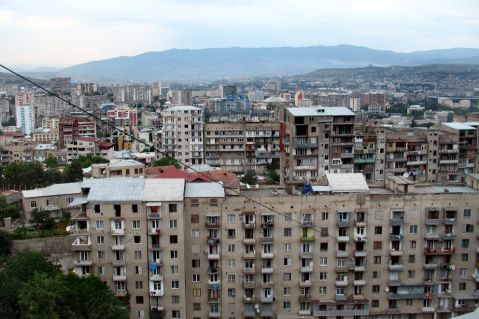04/08/09
Today we had a real meeting marathon. We met Edward and Sonia Balassanian founders of NPAK (Armenian Centre for Contemporary Experimental Art) and spoke about their work and their role in the Armenian arts scene.
As the main contemporary art gallery in the country, they play a significant role in shaping the artistic landscape and see themselves as catalysts whose job it is to “find new talent, promote them and let them go”.
We then met curator Marianna Hovhannisyan who works at Armenian Open University‘s department of Fine Arts. Their bachelor course provides a contemporary alternative to the very traditional Armenian Arts Academy. The regular teaching programme is accompanied by 5-6 workshops a year for students and graduates run by local and international practising artists. The artistic disciplines taught encompass video art and performance as well as oil painting and ceramics. Marianna showed us both the school and examples of work produced during workshops. The Open University also runs an art school for children and young people between the ages of 4 and 18.
We then met with Nazareth Karoyan, the president of AICA Armenia (International Association of Art Critics) who describes himself as a “cultural engineer”. He gave us a comprehensive overview of the history of contemporary art in Armenia starting from the 60s up until today.
04/08/09
Had a day out in the country yesterday. Edgar, Hovik and Garik introduced us to Vardan Jaloyan, secret nuclear physicist turned art critic, who took us out to his family home in the village of Urtsadzor (which was, seemingly, almost entirely built by his two brothers).
The hospitality we’ve received so far in Armenia has been quite overwhelming. It turned out that none of the visitors from Yerevan (Art Laboratory members) had been to Urtsadzor before but we had already been fed twice by the time we’d decided where to have the barbecue later in the afternoon.
The location decided upon was in the Khosrov Nature Reserve in the Geghama Mountain Range. On the way we visited Jamsho monastery and Fort Geghi which date from the 12th century and saw our first khatchkars (Armenian carved stone crosses).
We then found the perfect spot by a mountain brook and proceeded to the khoravats (barbecue) ritual which lasted for a few hours. Discussions ranged from politics, art, religion, history and the nature of progress.
On the way back to Yerevan, both relieved and disappointed not to have seen any of the bears, leopards, wolves or poisonous snakes that apparently frequent the area, we drove through a massive storm but arrived to dry streets.
02/08/09
We found a nicer place to stay – close to the opera, with paintings by our landlady and her father. Plus tea and cake:).
Met up with Tsomak, a music curator from Utopiana, a non-profit arts organization based in Geneva with an office in Yerevan, who introduced us to Yerevan’s alternative cultural scene.
In the afternoon we managed to find time for the Parajanov museum and then met Edgar Amroyan and Garik Yengibaryan from Art Laboratory collective who took us on a personalised tour of Yerevan complete with examples of local street art.
We finished the day at Hovhannes Margaryan‘s studio looking at documentation of Art Laboratory’s political works, actions and performances.
31/07/09
Yerevan is full of painters and cafes – seems like there’s one of each on every street corner. The first thing that strikes us is the heat – up to 40 degrees celsius. It is not too bad though as there is fresh watermelon juice everywhere. The Ararat mountain looks unreal, as if it was photoshopped into the skyline.
We arrived just in time to catch the end of the 4th edition of Summer Seminars For Contemporary Art Curators organised by AICA Armenia in the Mkhitar Sebastatsi Fine Arts College which also functions as a project space and a gallery for local and international artists and organisations. At the after party in the part of town known as Bangladesh (because of its remoteness from the centre of YErevan) we met artists and curators from all over Europe, the Middle East, the US and Armenia.




















